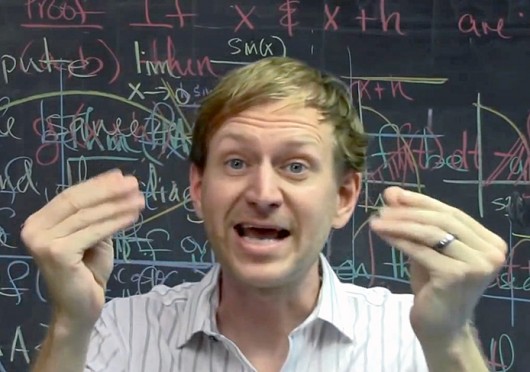
Bart Snapp, an OSU mathematics professor, helped create a Calculus One class offered through Coursera that has drawn students from around the world.
Credit: Courtesy of YouTube
Students in one Ohio State calculus class don’t have to sit in a lecture hall or pay tuition to learn.
Calculus One — a MOOC, or massive open online course, created by OSU professors — is offered through Coursera, a website offering classes online to students worldwide at no cost.
OSU is one of about 100 universities offering courses through Coursera, but the university is not making a profit from its relationship with Coursera.
Two OSU mathematics professors, Jim Fowler and Bart Snapp, created the Calculus One course. Fowler said he was drawn to Coursera partly because of its partnership with OSU.
A total of nine OSU courses are offered through Coursera, including Latin American Migration, Technology and Ethics, Human Trafficking and Introduction to Pharmacy.
Students, however, currently don’t receive any college credit for taking the class. They only receive a certificate.
Fowler said individual ambition to learn or lack thereof is often apparent in the class, something he thinks math instructors could help students with.
“The problem with math education is not just context education, it’s enthusiasm,” Fowler said.
The class, though, is made up of students worldwide, some of whom said their enthusiasm for calculus was what made them enroll.
“Math is nothing once you can understand it,” Shaheer Niazi said in a phone interview. He and his sister Khadija Niazi, 13-year-old students in Pakistan, found the course after a physics instructor told them they would need higher math to solve problems involving large celestial bodies.
Khadija Niazi said Fowler and Snapp were good teachers who communicated well with their class by responding to emails and answering questions.
Fowler said he thinks MOOCs will eventually be offered for credit similarly to how other online courses are offered for credit.
Coursera currently has a Signature Track service through which some of its university partners offer courses for official university recognition for a “small fee,” according to a Coursera release.
University of Michigan, University of Illinois at Urbana-Champaign and Duke University are among the schools offering at least one Signature Track course, according to a listing of courses on Coursera’s website. Prices for available Signature Track courses on Coursera’s website range from $30 to $90, according to the Coursera website.
Wayne Carlson, OSU’s vice provost for undergraduate studies and dean of undergraduate education, told The Lantern in September there was a possibility of money becoming involved down the line.
“Now down the road, there may be a business plan, a revenue stream that evolves and then at that particular point, we can enter into discussions with Coursera and the partners about how that revenue is shared. There is no such revenue right now,” Carlson said.
Some other OSU professors said the online class offers advantages aside from credit.
Roman Holowinsky, an OSU associate professor in the Department of Mathematics, said MOOC calculus courses give students the individual feedback lost in a lecture where of 120 students, only 10 might come to office hours. He said, though, while the immediate feedback of calculus MOOCs is great, learning is still up to the individual.
“The Internet is a natural resource for educational material, but I don’t know what the end result would be — even watching videos on a cassette was a revolutionary thing,” Holowinsky said.
Snapp and Fowler emphasize student interaction with the material in the Calculus One class.
Students who find mistakes in the online textbook used for the calculus course can submit edits, and if an edit is approved by Snapp or Fowler, it is applied to all of their other online textbooks.
“I want the student to take the material and make it their own,” Snapp said.
The course also tracks how long each student takes on individual problems and in browsing sections of the textbook, compiling data related to each student and the class as a whole.
Snapp said he and Fowler are working on understanding the learning strategies of students in an online situation and attempting to make their education better based on that data.
Jamie Walla, a high school calculus teacher in California, enrolled in the course as a refresher.
“I think the MOOC is a starting point for continuing education and global education because there are ways in which the live classroom cannot be replaced but there are advantages to online access that are so formidable that they really should be explored and refined,” Walla said.
Walla said she wants to be a resource for her students, so she took the class to review material she hadn’t used in years.
“(MOOC calculus) gave me insight into how technology will level the playing field for all of us,” Walla said. Walla is an Ohio native whose two sons attend OSU.
Fowler said Coursera is ideal for people who want to learn throughout their lives, as many of his students already have degrees.
Representatives for the OSU Office of Distance Education & eLearning said the department views the course as an opportunity.
“We don’t see that we are losing potential degree-seeking students to MOOCs but rather that we are engaging and inspiring individuals who would otherwise not have become part of the OSU family,” said Office of the Chief Information Officer communication director Katharine Keune in an email.
Coursera representatives did not respond to an email requesting comment.


